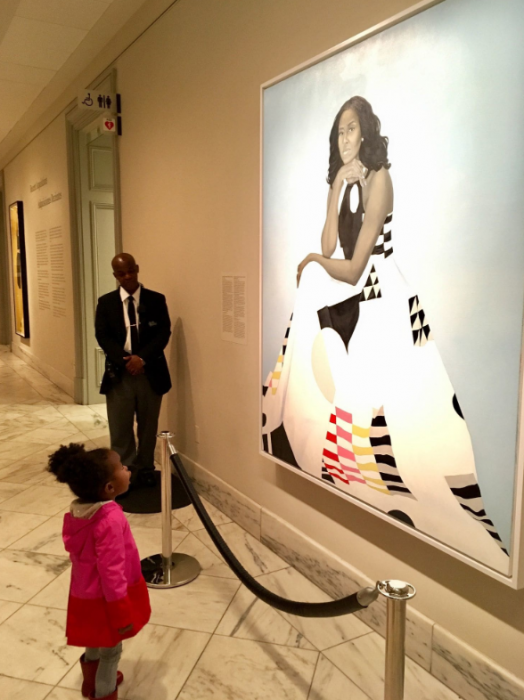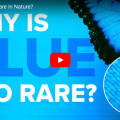Moments of Awe
Dr Skorton reflects on how a single moment of wonder—a child’s recognition of herself in a portrait, a glimpse of infinity in the first photo of a black hole—can change the world.
It’s an image that flew across Twitter. Two-year-old Parker Curry in her pink and red raincoat, staring up open-mouthed at the portrait of former First Lady Michelle Obama by Amy Sherald, displayed at the National Portrait Gallery. In a few days, the photo had been circulated thousands of times across social media. Obama even invited Parker to visit her office, where the two chatted and shared a dance party. When the Smithsonian American Women’s History Initiative launched this past March, Parker was there in the crowd at the National Portrait Gallery, wearing a dress that could have been pulled straight from the painting.

Parker Curry, 2, stands in awe of the new National Portrait Gallery painting of Michelle Obama. The photo was taken by another museum visitor, 37-year-old Ben Hines of North Carolina, who was in town visiting his parents, who live in Alexandria. (Photo by Ben Hines)
Like many others, I found the image hugely captivating. To me, it shows one of our core responsibilities, something that Mrs. Obama had articulated with remarkable prescience at the National Portrait Gallery’s unveiling ceremony, two weeks before the photo was taken.
“I’m thinking about all of the young people,” she said, “Particularly girls and girls of color, who, in years ahead, will come to this place and they will look up and they will see an image of someone who looks like them hanging on the wall of this great American institution.”
Moments like Parker’s reveal the extraordinary impact we have when people see themselves reflected in our work. At the Smithsonian, we have a unique lens through which to reveal ourselves, our nation, our world, and even our universe. With this opportunity comes a sacred responsibility: to emphasize the message, loud and clear, that the American experience belongs to everyone, and that everyone’s voice should be heard.
That’s why I am deeply proud of efforts from the American Women’s History Initiative, the Smithsonian Asian Pacific American Center, and the Smithsonian Latino Center, as well as the stories of inclusion, diversity, and opportunity that have proliferated across our museums. This work enables us to serve the American public better than ever before.
Parker isn’t alone. Walking through our galleries or our gardens, time and time again I see people of all ages and backgrounds standing in that same position that she was, transfixed by wonder and excitement.
And these moments of connection are not unique to our museums; our research and conservation activities inspire them too, as do our educational programs. Think of the chills of seeing the first-ever image of a black hole, or the hope that wells up when watching an endangered species reintroduced to the wild. Across so many ranges of human endeavor, our work sparks awe.
In that sense, we’re so much more than the keepers and explorers of the National Collections, as critical as this calling is and will continue to be; so much more than the “nation’s attic.” No, we’re more like the nation’s kindling. Take a twig of an idea, add heat and oxygen, and soon you have a flame. When we ignite that sense of curiosity and optimism, when young people like Parker experience our work and see new possibilities, we have done our job well: to surprise, amaze, and inspire.
This is a grand and difficult task. As the city, the country, and world change around us, it requires ongoing, constant work to serve in this way.
That we do so with any measure of success comes down to outstanding colleagues.
A few weeks ago, at the Smithsonian’s Unsung Hero Awards, I was reminded of the talent, excellence, and dedication of the people who are the Institution’s engine. As always, I was deeply impressed by the stories of how Smithsonian heroes go above and beyond every day and many nights.

The 2019 Unsung Heroes of the Smithsonian, May 16, 2019. (Photo by Michael Barnes)
That event sticks with me, but not only because of the individuals on the stage. I remain in awe of the community that came out to support them. With applause, cowbells, and posters, it was a raucous crowd. Historians cheering for locksmiths, gardeners cheering for administrators – the energy was unmistakable. I was reminded, again, of what an enduring privilege it has been to work with this group of people and with all of you.
We’re at our best in these moments, when we come together across disciplines to fulfill the promise of being One Smithsonian. With an institutional milieu that includes everything under the sun, this is not an easy goal. But as I reflect on my time here, it’s our efforts to increase collaboration and build community across disciplines, fields, and backgrounds that make me so optimistic about the future of this Institution.
As I pass the torch to our next Secretary, I know that the Smithsonian is in enormously capable hands. I have deep confidence in Lonnie’s leadership. This is a man who has already made incredible contributions to the Smithsonian, to this country, and far beyond. He understands what makes us extraordinary and the ways we’ll need to continue to adapt and grow to fulfill our mission. I am excited to see where he’ll take this Institution next.
I may not have the first-rate poster-making abilities or the cowbells that some of our staff do, but know that I’ll be cheering the entire Smithsonian along just the same.
Posted: 3 June 2019
-
Categories:
Astrophysical Observatory , From the Secretary , Portrait Gallery




